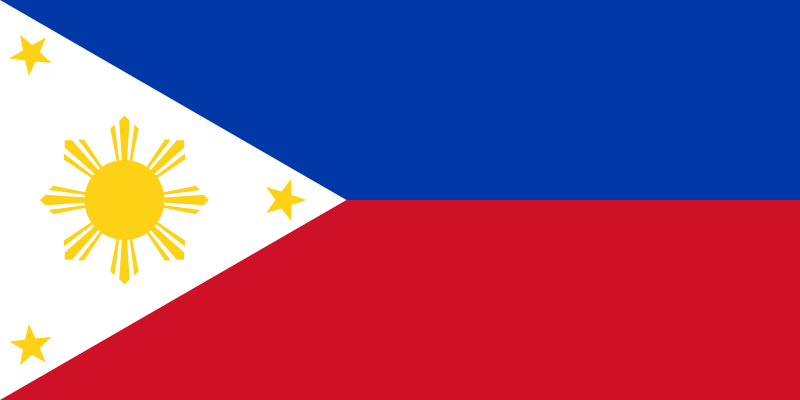National Symbols: Flag Details
Date First Used
June 12, 1898 (current version 1998)
Nickname(s)
“Pambansang Watawat ("National Flag")
Design Elements
Blue over red bicolor with a white equilateral triangle at the hoist containing a yellow sun and three yellow five-pointed stars.
Symbols: The sun represents the dawning of a new era of self-determination following the Spanish-American war and the promise of independence. The eight rays on the sun stand for the eight provinces that rose in revolt against Spanish rule in the late 19th century. The three stars stand for the three principle geographic areas of the country, Luzon, the Visayas and Mindanao. The white triangle originally stood for the Katipunan, an organization that led the revolt against Spain.
Colors: Red represents courage and bravery, blue stands for noble ideals, and white symbolizes peace and purity.
Proportions: 1:2
Variations: In peacetime, the blue stripe is uppermost; during war, the red stripe is on top. In the vertical position, blue on the right means peace and the opposite means war.
History
The flag of the Philippines has gone through a number of design changes in the past two centuries. The first modern Philippine flag was conceived by exiled independence fighter General Emilio Aguinaldo in 1897 and first displayed in battle on May 28, 1898. This flag—the horizontal bicolor with the white triangle at the hoist bearing a yellow sun—was raised during the proclamation of independence from Spain on June 12, 1898, in Kawit, Cavite.
The original design of the flag portrayed a sun with a face, a symbol common to several former Spanish colonies. The particular shade of blue of the original flag has been a source of controversy. Most historians argue that the colors of the original flag were the same blue and red found on the Cuban flag. (Cuba's flag influenced the design of the flag of the Philippines much as Cuba's revolution against Spain helped inspire the Philippine Revolution.)
The Commonwealth of the Philippines was inaugurated in 1935, and on March 25, 1936, technical descriptions and specifications for the flag were issued. Among the provisions of the order was the definition of the triangle as an equilateral, the stipulation of the aspect ratio at 1:2, the precise angles of the stars, the geometric and aesthetic design of the sun, and the formal elimination of the mythical face on the sun. The exact shades of the colors, however, were not precisely defined until 1998 during the centennial for the proclamation of Philippine independence.
Proper Uses
The Philippine flag law of 2008 states that "when the Philippine flag is flown with another flag, the flags, if both are national flags, must be flown on separate staffs of the same height and shall be of equal size." It also directs that "the Philippine flag shall be hoisted first and lowered last." Prohibited acts include lowering the flag to salute or compliment any person or object; displaying the flag "under any painting or picture, horizontally face-up, below any platform, or in discotheques, cockpits, night and day clubs, casinos, gambling joints and places of vice or where frivolity prevails;" wearing the flag in whole or in part as a costume or uniform; adding "any word, figure, mark, picture, design, drawings, advertisement, or imprint of any nature on the flag;" using the flag as “part of any advertisement or infomercial;" and displaying the flag in front of buildings or offices occupied by those who are not Filipino citizens.
Legends, Controversies, and Trivia
The history of the colors of the flag of the Philippines is remarkably convoluted. When American forces occupied the country at the turn of the 20th century, the display of the Philippine flag was prohibited and severe punishment was accorded violators. When the prohibition was lifted 11 years later, cloth in the original shades of the flag (thought to have been the shades of red and blue found on the Cuban flag) were impossible to find. Instead, all the available material reflected the red and blue found on the American flag. From 1919 on, these shades became the de facto colors of the Philippine flag. With the Japanese invasion and occupation of the islands in 1941, the Philippine flag was once again outlawed. It was hoisted again with the establishment of the puppet (or Second) Philippine Republic in 1943, at which time the Cuban blue and red colors reportedly were restored.
When American forces returned in 1944, the "Stars and Stripes"—inspired red and navy of the 1936 flag were restored. This version of the flag was raised upon the United States’ recognition of Philippine independence on July 4, 1946, and endured until President Ferdinand Marcos ordered the original Cuban blue and red reinstituted in 1981. After the People Power Revolution in 1986, the Marcos colors were abolished and the pre-Marcos colors restored. Finally, in 1998, for the centennial of the proclamation of Philippine independence, a law governing the color shades was passed, changing the color of the blue in the flag to "royal blue," a compromise reached after much polarizing public and historical debate.
Copyright © 1993—2025 World Trade Press. All rights reserved.

 Philippines
Philippines 